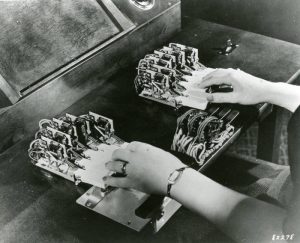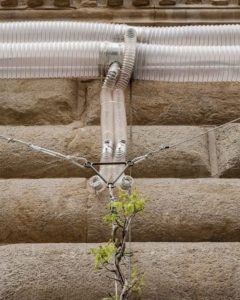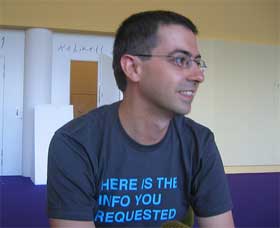 Alessandro Ludovico is a media critic and editor in chief of the highly respected Neural magazine from 1993, (Honorary Mention, Prix Ars Electronica 2004). He is the author of several essays on digital culture, he co-edited ‘Mag.Net Reader’ (1 and 2). He’s one of the founding contributors of the Nettime community, one of the founders of the Mag.Net (Electronic Cultural Publishers)’ organization and he teaches ‘Computer Art’ and ‘Interface Aesthetics’ at the Academy of Art in Carrara.
Alessandro Ludovico is a media critic and editor in chief of the highly respected Neural magazine from 1993, (Honorary Mention, Prix Ars Electronica 2004). He is the author of several essays on digital culture, he co-edited ‘Mag.Net Reader’ (1 and 2). He’s one of the founding contributors of the Nettime community, one of the founders of the Mag.Net (Electronic Cultural Publishers)’ organization and he teaches ‘Computer Art’ and ‘Interface Aesthetics’ at the Academy of Art in Carrara.
I think that’s more than enough for a sole man.
Not for him apparently. Not only does he wear great t-shirts*, he also collaborates with UBERMORGEN and Paolo Cirio on artistic projects which have toured the world: GWEI – Google Will Eat Itself (Honorary Mention Prix Ars Electronica 2005, Rhizome Commission 2005, nomination Prix Transmediale 2006) and Amazon Noir (1st prize Stuttgarter Filmwinter 2007, Honorary Mention Share Prize 2007).
When I met him several years ago, i also realized that i had no chance of ever winning the contest for the “Nicest person in the new media art world.” Sigh!
How did Neural start?
After being a passionate mail artist and zine fan in late eighties, in 1991 I started working as a graphic designer for Minus Habens Records (an underground electronic music label based in Bari, Italy). After a few months I was in charge to curate a special product: an early slim printed guide to virtual reality (the Virtual Reality Handbook), made out of theoretical text and resources, coming with an inspired music CD. It was sold out in less than a year, so I proposed to Ivan Iusco (the label owner) to found a magazine focusing on new technologies’ cultural implications.
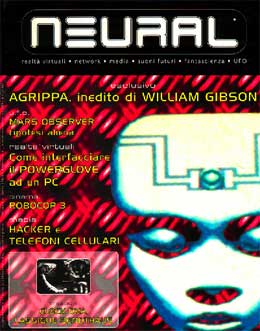 We worked hard on it so the first Neural issue was printed in November 1993. Topics ranged from cyberpunk to electronic music, computer art and BBS networks (the popular Internet ancestors), and even if it was almost naive compared to the current magazine it reflected the thrill of investigating a new world of personal communication and content sharing possibilities. In 1995 I continued to experiment with publishing with another hybrid printed/music product. It was called Internet Underground Guide, a guide to the most obscure parts of the rising global network, with a music compilation assembled only via the electronic mail medium (perhaps the first music compilation made on the net). In the same year I was invited to the Venice Bienniale symposium called >net.time, where, in the end, the homonymous mailing list [http://www.nettime.org] was founded. During the three days of symposium there was such an intensive exchange of ideas and perspectives that a real international network of active persons involved with art, technology and politics was established. The various related international events (Next Five Minutes, 1996, The Beauty and the East, 1997, Net.Congestion 2000, the Italian Hackmeetings 1998-today, just to name a few) that followed were really precious to expand my personal network of friends, artists, hacktivists and theoreticians, reporting some of the most interesting concepts on the printed pages of Neural.
We worked hard on it so the first Neural issue was printed in November 1993. Topics ranged from cyberpunk to electronic music, computer art and BBS networks (the popular Internet ancestors), and even if it was almost naive compared to the current magazine it reflected the thrill of investigating a new world of personal communication and content sharing possibilities. In 1995 I continued to experiment with publishing with another hybrid printed/music product. It was called Internet Underground Guide, a guide to the most obscure parts of the rising global network, with a music compilation assembled only via the electronic mail medium (perhaps the first music compilation made on the net). In the same year I was invited to the Venice Bienniale symposium called >net.time, where, in the end, the homonymous mailing list [http://www.nettime.org] was founded. During the three days of symposium there was such an intensive exchange of ideas and perspectives that a real international network of active persons involved with art, technology and politics was established. The various related international events (Next Five Minutes, 1996, The Beauty and the East, 1997, Net.Congestion 2000, the Italian Hackmeetings 1998-today, just to name a few) that followed were really precious to expand my personal network of friends, artists, hacktivists and theoreticians, reporting some of the most interesting concepts on the printed pages of Neural.
The magazine was developed on challenging ideas, trying to give them a proper visual frame. I cared a lot about design and how it could have expressed electronic culture in a sort of printed ‘interface’. So, for example, the page numbering was strictly in binary numbers, just zero and ones, even if the printer started to complain loudly about that because this was driving him crazy. And from the beginning another ‘sensorial experience’ was placed on the centerfold, reprinting optical artworks and theories in various forms, giving readers an aesthetic mind trip while reading. In issue 18 this habit was definitively interrupted, publishing a disrupting hacktivist fake. It consisted of fake stickers, created by the Italian hacker laboratories’ network, sarcastically simulating the mandatory real ones sticked on any book or compact disc sold in Italy, on behalf of the local ‘copyright protection society’ (called SIAE). On the one published it was printed ‘suggested duplication on any media’. In 1998 we restyled the layout and restructured the contents, defining three sections. They still are: hacktivism, activism made through a conceptual/technically media hack, electronic music, investigating how technology is involved in music production and consumption, and media art, with a peculiar attention to the networked and conceptual use of technology in art. In 2000 I used a substantial part of music Neural content for the book Suoni Futuri Digitali (Future Digital Sounds), an in-depth research, chronicling the history of the innovations that have drastically changed how we produce and experience sounds. In 2003 (while maintaining the Italian edition) I started the Neural English edition, printed in 4000 copies. Actually it is distributed worldwide with subscribers from literally all over the world, and most of them are curators, artists, critics, students, professors and libraries. Neural.it website went online in may 1997, a decade ago, and it was updated every two weeks. Starting from November 2000, it is daily updated and from 2004 it’s in English (and of course still in Italian too).
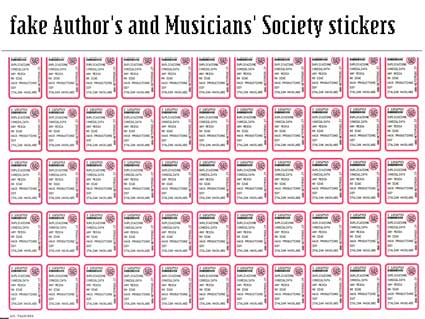 Image courtesy of Alessandro Ludovico
Image courtesy of Alessandro Ludovico
Have you seen the readership of Neural evolve over time?
Definitively. In the last 15 years readers mostly followed the fast and furious changes of printed publishing literally disrupted by the online medium advent and the pervasive digital influence in printing production. When we started we had ‘letters to the editor’ (a sort of ancient blog’s comments) and the most compelling sources were found in bookstores and obscure mail orders.
Neural started an ‘Internet news’ column in 1994, but in a few years things changed quickly. People started to find information online in real time, with amazing search possibilities. This completely redefined the role of magazines, from generic content container, to highly selected, conceptually strong and longer than average content frame. Moreover, it’s essential to notice how the readership evolves, and their changing needs.
It’s not a question of being shaped by a (niche) market, but to mediate the editorial interests with what’s really interesting for the readers, keeping an eye to: language evolution, new technical ‘default’ (what’s not meant to be explained) and new area of interests. It’s sad in the last decade that many interesting independent magazines were not able to catch up this fast evolution and had to close. My cultural strategy to survive is to seriously value the readers’ feedback. And I’m not really talking about compliments. I receive some, but they are mostly important for the morale. Critics are vital, instead, to understand what is the next thing to modify, change, implement or delete. It’s not a democratic process because in the end I take the final decision, but it’s a collective help I receive without soliciting. So the magazine’s editorial line is changed (even slightly) every printed issue, and the same happens to the website.
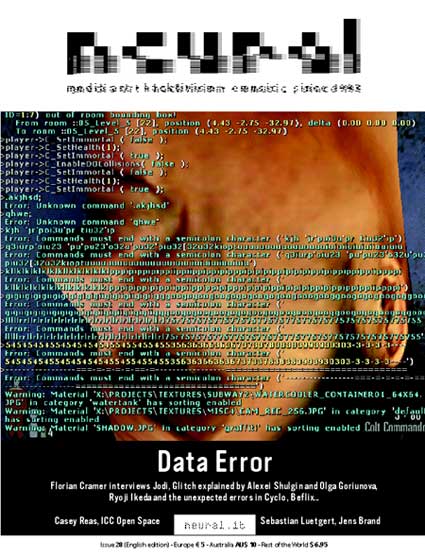
Cover of the latest issue of Neural
Neural is still everyone’s favorite even if today several blogs/online magazines, etc. are trying to get a place on your turf. How do you maintain the “cult” status that neural has?
Frankly, I never bored of being ‘cult’ that means that if Neural is ‘cult’ that’s only by accident. Some people even told me that they think of Neural as a work of art. I don’t know whether it really is or not, but actually the website even won an Honorary Mention in Prix Ars Electronica 2004, in the Net.Vision category, and even if I’m a bit critical about prizes, I was honored (anyway in the end I think that my real prize are the tens of thousands of incoming links).
 Truth is: I simply use instinct, experience and outer feedback in running the magazine. Sometimes I think of Neural as an info-gallery, the best info-gallery I’d want to read. If you want, it’d be defined as my personal narrative of the digital culture evolution, formed by important chunks of information condensed in a limited space. Concerning the ‘turf’, I always thought that the more cultural efforts (including blogs and magazines) are made to discuss (and then implicitly promote) digital culture the more we’ll get out of the actual ghetto. Nevertheless as John Perry Barlow once said “You can’t steal what’s inside my mind.” And this is true for every intellectual product (so also for blogs/magazines). People are interested not just in one, but in different good products and not really in clones (unless you enter the mass commercial market). Furthermore experience still counts a lot: no matter what’s the work I always admire persons really experienced in one specific field. In the end I definitively think that Neural is a huge effort made over time with tons of passion and some discipline. One of the main characteristics of digital culture is spreading fast powerful ideas. A good technical hack, as an innovative use of sound, or an original concept shown in a proper digital artwork, are meaningful signals. These signals are ideas, which have to be shared among the worldwide interested community, for a participative development. The aim of Neural is to vehiculate meaningful ideas within local and international networks. This is my primary purpose.
Truth is: I simply use instinct, experience and outer feedback in running the magazine. Sometimes I think of Neural as an info-gallery, the best info-gallery I’d want to read. If you want, it’d be defined as my personal narrative of the digital culture evolution, formed by important chunks of information condensed in a limited space. Concerning the ‘turf’, I always thought that the more cultural efforts (including blogs and magazines) are made to discuss (and then implicitly promote) digital culture the more we’ll get out of the actual ghetto. Nevertheless as John Perry Barlow once said “You can’t steal what’s inside my mind.” And this is true for every intellectual product (so also for blogs/magazines). People are interested not just in one, but in different good products and not really in clones (unless you enter the mass commercial market). Furthermore experience still counts a lot: no matter what’s the work I always admire persons really experienced in one specific field. In the end I definitively think that Neural is a huge effort made over time with tons of passion and some discipline. One of the main characteristics of digital culture is spreading fast powerful ideas. A good technical hack, as an innovative use of sound, or an original concept shown in a proper digital artwork, are meaningful signals. These signals are ideas, which have to be shared among the worldwide interested community, for a participative development. The aim of Neural is to vehiculate meaningful ideas within local and international networks. This is my primary purpose.
I know how hard and time-consuming it can be to write an online magazine, how do you manage to maintain an online presence and publish the paper magazine regularly? please, tell us you live alone in a grotta and workers in developing countries are writing most of the content for you.
Apart from kidding, I know it’s almost insane. Especially because I’m still obsessed in caring about each step of production, to achieve the best content quality I can afford. But again passion and the inestimable support I receive are continuously motivating me to go on and improve. It’s a question of never stop to optimize processes and time management, also improving the gained experience. I’m still chaotic, as you might guess, but I’m definitively committed to continue and to make the project the better and the more sustainable I can. Now Aurelio Cianciotta is the music co-editor and we weekly deal with stuff from almost a decade. Paolo Cirio is the online platform guru, so also the person who made possible the Movable Type-based website (after years of cut and paste routines in html), while Roberto Orsini helps me so much with translations. Among the contributors, Valentina Culatti is the most generous in donating her time to Neural, but also skilled writings come regularly from Vito Campanelli, and Tony Canonico. They are all Italians, but this is only a coincidence and I’m also looking for skilled voluntary contributors from abroad. Going back on how to produce paper and online content, I’m developing a workshop, with Simon Worthington (co-founder of Mute magazine), to share our long experience with other independent publishers. I was a zine fan in the late eighties, so I still think that independent publishing should exploit every digital technology to enrich the freedom of expression many possibilities.
In the beautiful text “Paper and Pixel, the mutation of publishing” that you have written for The Mag.net reader, you talk about the changing role of the printed page. Can you explain us the reason why you keep on printing the magazine instead of relying only on a pixel version of it?
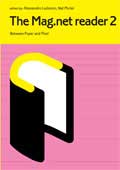 I think that paper is not supposed to die anytime soon. For that text I researched how the ‘death of paper’ was announced more than once in the past, after some major ‘new’ media announcement (radio, pc, the net …). But it simply never happened. Actually, paper is the most stable medium in a crowded mediascape of ‘unstable media’. Once produced it doesn’t need electricity to be enjoyed and it is mobile as our life is more and more going to be. But, as I said above, we have to face that paper today means luxury. It means having time to enjoy reading in a comfortable way. Interesting paper content is not inducing banal ‘flipping pages’ habits. It’s enticing in spending time on it, without burning your eyes in front of a screen light more or less instinctively clicking somewhere, and having the chance to simply interrupt the reading whenever you want and pick it up again in an arbitrary moment. And especially for specific niche and artistic data, the stability and feel of paper is still unbeatable (it’s what I’ve tried to define as ‘the persistence of paper’ in an essay published on the Magnet Reader 2). These processes are even more interesting when the content is related to digital culture, because the medium becomes also the place where it itself is discussed. With some of these premises I was invited to join eleven independent editors at the Universidad Internacional de Andalucía in Seville (Spain) in 2002, for a series of seminars and lessons entitled Post-Media Publishing, print-publishing and networks for electronic culture, coordinated by Andreas Broeckmann. It was a unique opportunity to join efforts with other editors and create an informal network of collaboration. So we founded Mag.Net (Magazine Network), Electronic Cultural Publishers. Our motto is “collaboration is better than competition” and we collaborate commissioning contents each other, sharing the knowledge on specific topics (like the online paying platforms, or the print-on-demand technologies), and working jointly on some projects, not necessarily all at the same time. The most tangible effort has been the Mag.Net reader, a book about the digital/printed content relationships, freely downloadable from the Mag.Net website or purchasable as a physical paper book through a print on demand platform. Actually the most active Mag.net members are Mute [UK], Springerin [AT], Zehar [SP], 3/4 Revue [SK] and Neural. Among the latest Mag. Net initiatives were a conference that took place in January 2007 at the Amsterdam’s De Balie theatre called ‘Offline ? Online Publishing: The Love for Print in an Age of Electronic Media’, the Mag.Net Reader 2 that I edited with Nat Muller, and that was launched during the last DEAF (Dutch Electronic Art Festival) in Rotterdam, in April, and the Paper and Pixel week of panels and presentations I curated with Nat again for the Documenta 12 Magazine project in Kassel. Neural was part of this project (involving more than 90 independent art magazines form all over the world], and I was advising them for the online part. Finally in the last September I was invited by ANAT to give some workshops about the history of independent publishing, differences and similarities between online and offline media and how the open source culture can be applied to publishing. I’m editing with Nat the 3rd Mag.net Reader that will be published in 2008.
I think that paper is not supposed to die anytime soon. For that text I researched how the ‘death of paper’ was announced more than once in the past, after some major ‘new’ media announcement (radio, pc, the net …). But it simply never happened. Actually, paper is the most stable medium in a crowded mediascape of ‘unstable media’. Once produced it doesn’t need electricity to be enjoyed and it is mobile as our life is more and more going to be. But, as I said above, we have to face that paper today means luxury. It means having time to enjoy reading in a comfortable way. Interesting paper content is not inducing banal ‘flipping pages’ habits. It’s enticing in spending time on it, without burning your eyes in front of a screen light more or less instinctively clicking somewhere, and having the chance to simply interrupt the reading whenever you want and pick it up again in an arbitrary moment. And especially for specific niche and artistic data, the stability and feel of paper is still unbeatable (it’s what I’ve tried to define as ‘the persistence of paper’ in an essay published on the Magnet Reader 2). These processes are even more interesting when the content is related to digital culture, because the medium becomes also the place where it itself is discussed. With some of these premises I was invited to join eleven independent editors at the Universidad Internacional de Andalucía in Seville (Spain) in 2002, for a series of seminars and lessons entitled Post-Media Publishing, print-publishing and networks for electronic culture, coordinated by Andreas Broeckmann. It was a unique opportunity to join efforts with other editors and create an informal network of collaboration. So we founded Mag.Net (Magazine Network), Electronic Cultural Publishers. Our motto is “collaboration is better than competition” and we collaborate commissioning contents each other, sharing the knowledge on specific topics (like the online paying platforms, or the print-on-demand technologies), and working jointly on some projects, not necessarily all at the same time. The most tangible effort has been the Mag.Net reader, a book about the digital/printed content relationships, freely downloadable from the Mag.Net website or purchasable as a physical paper book through a print on demand platform. Actually the most active Mag.net members are Mute [UK], Springerin [AT], Zehar [SP], 3/4 Revue [SK] and Neural. Among the latest Mag. Net initiatives were a conference that took place in January 2007 at the Amsterdam’s De Balie theatre called ‘Offline ? Online Publishing: The Love for Print in an Age of Electronic Media’, the Mag.Net Reader 2 that I edited with Nat Muller, and that was launched during the last DEAF (Dutch Electronic Art Festival) in Rotterdam, in April, and the Paper and Pixel week of panels and presentations I curated with Nat again for the Documenta 12 Magazine project in Kassel. Neural was part of this project (involving more than 90 independent art magazines form all over the world], and I was advising them for the online part. Finally in the last September I was invited by ANAT to give some workshops about the history of independent publishing, differences and similarities between online and offline media and how the open source culture can be applied to publishing. I’m editing with Nat the 3rd Mag.net Reader that will be published in 2008.
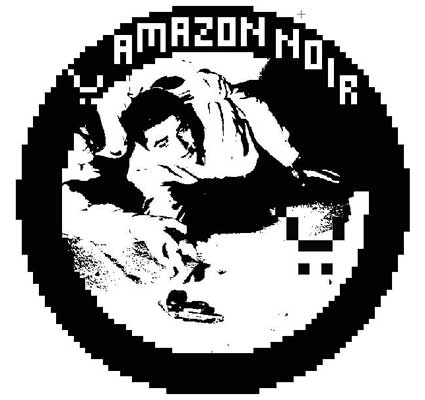 Amazon Noir
Amazon Noir
How do you explain that most “traditional” art magazines are still snubbing new media art?
In (new) media art the fetish physical component, i.e. the marketable object, is often missed. The infinite reproduction of the work of art is a process yet to be digested even by the contemporary art world. So traditional art magazines that are basically funded by the art market, are relegating it as a marginal and (sort of) exotic phenomenon for its economical scale. And we’d also consider the technical side. Dealing with hardware and software, media art aesthetics and narrative could be mind-boggling for curators and institution directors (often in their sixties or even older). Finally we should consider that video art was recognized by the art world only after twenty years from its early stage, because it suffered from similar problems.
And beyond all that, there’s a fruitless terminology prolificness that is silently killing the scene: in the beginning it was called ‘cyber art’, then new media art, digital art, web art, etc. etc.) Needless to say the ‘new’ term in ‘new media art’ is already ‘old’. But the terminology game based on catching the most recent buzzword and applying it to ‘art’ is even worst. So we had ‘browser art’, and then ‘device art’, ‘interface art’ or even ‘rfid art’. But does it really makes sense?
I think it doesn’t, and it endlessly breaks up an ethereal and problematic identity. William Gibson said once in late eighties “there was science slash humanism. Let’s start to talk about the slash”. I choose not to be obsessed by the most traditional art market, placing Neural on the opposite of new media art “snubbers”. So I’m still focusing a substantial part of my personal research on the edges of the so-called ‘new media art’, on topics like spam, viruses, peer-to-peer networks (the last two developed thanks to the support of Franziska Nori) and how the ‘perfect’ marketing strategies of online giants can be ‘hacked’. My humble opinion is that they are all possible testbed of future standard communication protocols, and so media potentially used for propaganda and mass marketing.
How would you describe the situation in Italy for computer and technology based art? Can you recommend some Italian artists who should get more attention outside of the country?
Unfortunately, Italy is not the ideal country to develop digital art projects. We have too much ancient and classical art heritage to hope for serious institutional support in contemporary art (and even less to digital based art). Nevertheless, there are persons with which I share some of my working paths. For example the ‘Scuola di Nuove Tecnologie dell’Arte’ (School of New Technologies in Art, part of the Carrara’s Academy of Art) directed by Tommaso Tozzi is one of the national points of reference. I totally share his passion on the subject (for example he’s developing an important collective and shared WikiArtPedia project on the Networked Arts history), and I was very happy to join the school actually teaching ‘Computer Art’ and ‘Aesthetic of Interfaces’ courses. But there are many different small initiatives around, and recently it seems even trendy to claim a Saturday night vjing in a small club as an ‘electronic art and music festival’. My favorite festivals are Interferenze and PEAM in the center-south and Share in the north. In this field my personal experience goes back to 1996 when I was actively supporting the group that made one of the first ‘new media art’ exhibitions with Italian artists called Virtual Light (Aurelio Cianciotta was then one of the curators). It definitively was a success, but the curators had already spent two years to convince the municipality to fund the effort. My first reference in early nineties was Decoder, an underground magazine that introduced the concept of cyberpunk as a political movement, including art expressions at large. Actually the mailing list AHA – Activism, Hacktivism, Artivism, moderated by Tatiana Bazzichelli is the most popular electronic forum on electronic art in Italy. Generally speaking, anyway, there are Italian digital art productions more aesthetically oriented (Limiteazero, 80/81, Luigi Pagliarini, Chiara Passa, just to name a few well known, but there’d be way too many to cite), and the one with a specific political background. Among the latter, the Luther Blisset initiative (that I consider one of the most important cultural event in the nineties) influenced subsequent groups and initiatives as the 0100101110101101.ORG, epidemiC, Serpica Naro and many others, and on the same wavelength there are Molleindustria, Candida TV and the whole Telestreet movement with the New Global Vision archive, Dyne.org free software house, Sexyshock, my colleague Paolo Cirio, again only to name a few. Finally, even if it’s not recognized as ‘art’, I think that the Hackmeetings are really a performative collective ‘art’ event. It’s a hacker meeting completely self-organized through a mailing list taking decision on every aspect of the meeting with an anarchic playful spirit and gathering nonetheless a few thousands hackers in a different place every year from a decade, sharing knowledge and establishing/reinforcing human relationships and political awareness. I attended all of them from the beginning (except the last three), because of the incredible atmosphere and the deep social exchanges that I had there. But to answer your last question I think that Luca Bertini has not yet gained some (well deserved) attention, and it’s a real pity because I think he’s one of the most inventive and controversial Italian media artists. Finally in spring 2008 I’ll start the ‘Neural Archive’ project, creating an online database of bibliographical references to all the physical stuff I have in my personal archive (books, dvds, cd-roms, ephemerals), to create a free online resource for researchers.
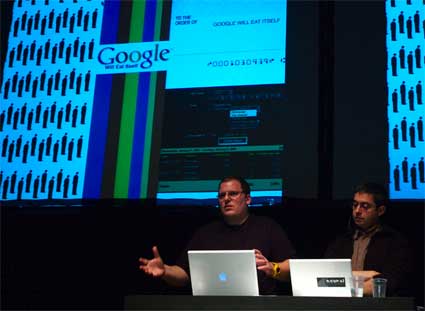 Image courtesy of Alessandro Ludovico
Image courtesy of Alessandro Ludovico
Together with UBERMORGEN and Paolo Cirio you have realized Google Will Eat Itself, an artistic project that aims to buy out Google with funds generated from Google Adsense. How did google react to GWEI?
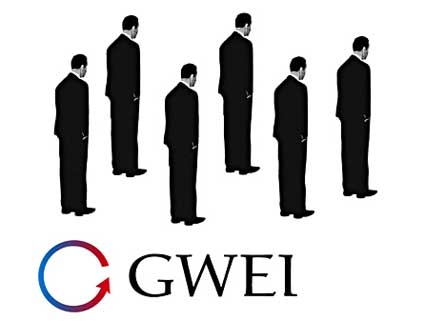 Well, the official reaction of Google was a ‘cease and desist’ letter of their German branch. But it was very different from the other ‘cease and desist’ letters I’ve seen, it was a sort of confidential letter, not the usual cold lawyer-lexicon style one. But nevertheless even more frightening. It basically said, “ok, we understand it’s art, but you have to stop it now”. It matches what I think is their status of ‘funny dictator’, as I’ve tried to define it. In fact there were so many mysteries and strange facts during the project that I and Hans Bernhard did a whole lecture/performance on that at the v2‘s TANGENT_CONSPIRACY night, in December 2006 (video). Furthermore Google Italy, indeed, terminated the Neural.it AdSense account without any explanation. I think that was quite stupid because Neural.it has never been part of GWEI (this was clear from the beginning to all of us). But Goggle Italy was too blind minded to understand that, so just after being invited to a public debate with me and Paolo, they simply refused to come and terminated the Neural account because of ‘fraudulent clicks’ that never happened there. But you’d take in count that they grant the AdSense money so they can anytime decide to terminate your account without any real proof. That’s also part of what I defined as their ‘porcelain interface’. GWEI was for me one of the most fascinating experience I had: it was (unexpectedly for me) incredibly successful and it let me experience for the first time the artistic dimension inside a very skilled team, so sharing with Hans, Liz and Paolo all the (good and bad) moments. I’m really grateful to them.
Well, the official reaction of Google was a ‘cease and desist’ letter of their German branch. But it was very different from the other ‘cease and desist’ letters I’ve seen, it was a sort of confidential letter, not the usual cold lawyer-lexicon style one. But nevertheless even more frightening. It basically said, “ok, we understand it’s art, but you have to stop it now”. It matches what I think is their status of ‘funny dictator’, as I’ve tried to define it. In fact there were so many mysteries and strange facts during the project that I and Hans Bernhard did a whole lecture/performance on that at the v2‘s TANGENT_CONSPIRACY night, in December 2006 (video). Furthermore Google Italy, indeed, terminated the Neural.it AdSense account without any explanation. I think that was quite stupid because Neural.it has never been part of GWEI (this was clear from the beginning to all of us). But Goggle Italy was too blind minded to understand that, so just after being invited to a public debate with me and Paolo, they simply refused to come and terminated the Neural account because of ‘fraudulent clicks’ that never happened there. But you’d take in count that they grant the AdSense money so they can anytime decide to terminate your account without any real proof. That’s also part of what I defined as their ‘porcelain interface’. GWEI was for me one of the most fascinating experience I had: it was (unexpectedly for me) incredibly successful and it let me experience for the first time the artistic dimension inside a very skilled team, so sharing with Hans, Liz and Paolo all the (good and bad) moments. I’m really grateful to them.
Let’s talk about Amazon Noir. What are the latest developments? Has Amazon reacted to the project?
Amazon noir is still going on with its most visible outcome: the stolen book files. We’re still re-embodying them in different forms. We developed an installation that physically (and very symbolically) embodies the project. It consists of two overhead projectors displaying the logo and the diagram of our software internal mechanisms, and an incubator with one of the stolen book inside, reprinted digitally. Symbolically we chose the American counterculture classic from the seventies ‘Steal This Book’ by Abbie Hoffman. We in a way re-embodied the book (obtaining cover and complete textual content from Amazon) in its mutated physical form. But we also placed a warning near the incubator. It stated: “The book inside the incubator is the physical embodiment of a complex Amazon.com hacking action. It has been obtained exploiting Amazon ‘Search Inside The Book’ tool. Take care because it’s an illegitimate and premature son born from the relationship between Amazon and Copyright. It’s illegitimate because it’s an unauthorized print of a copyright-protected book. And it’s premature because the gestation of this relationship’s outcome is far for being mature.” That was why I thought that we ‘stole the invisible’ [http://amazon-noir.com/thieves.html]. It’s an installation showing a net art piece without any IT or internet connection. Actually, various people tried to steal the book opening the incubator, claiming that they simply do what is written on the cover (we personally kindly asked some of them to put the book back, and one of them actually succeeded in stealing it during the Shift festival opening in Basel and we had to find out how to replace it quickly). This is also a proof that, ironically enough, it was also very ‘interactive’.
About the Amazon reaction, they reverse-engineers the software, making the robot useless. We, indeed, spread all the books we downloaded through peer-to-peer networks (bittorrent, gnutella, fast track, emule, etc.).
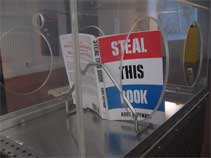
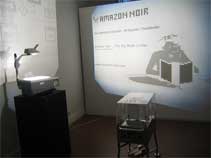 Amazon Noir installation at the Share Festival in Turin, March 2007
Amazon Noir installation at the Share Festival in Turin, March 2007
The installation was exhibited in various museums and festivals in different countries and it has been actually nominated for the upcoming Tansmediale Award 2008. I’ve tried to conceptually develop a whole theoretical concept about the big online corporations marketing strategies and their potential hacking in an essay entitled “The (online) economy of desire”. It’ll be online soon.
Thanks Alessandro!
Related interview: Interview with UBERMORGEN.
Related story: How to survive the paper industry.
*here’s the way to spam-clothing bliss.

![7 art and tech ideas I discovered at Meta.Morf 2024 – [up]Loaded Bodies 7 art and tech ideas I discovered at Meta.Morf 2024 – [up]Loaded Bodies](https://we-make-money-not-art.com/wp-content/uploads/2024/05/53705969154_73dfdfea6f_c-300x200.jpeg)

